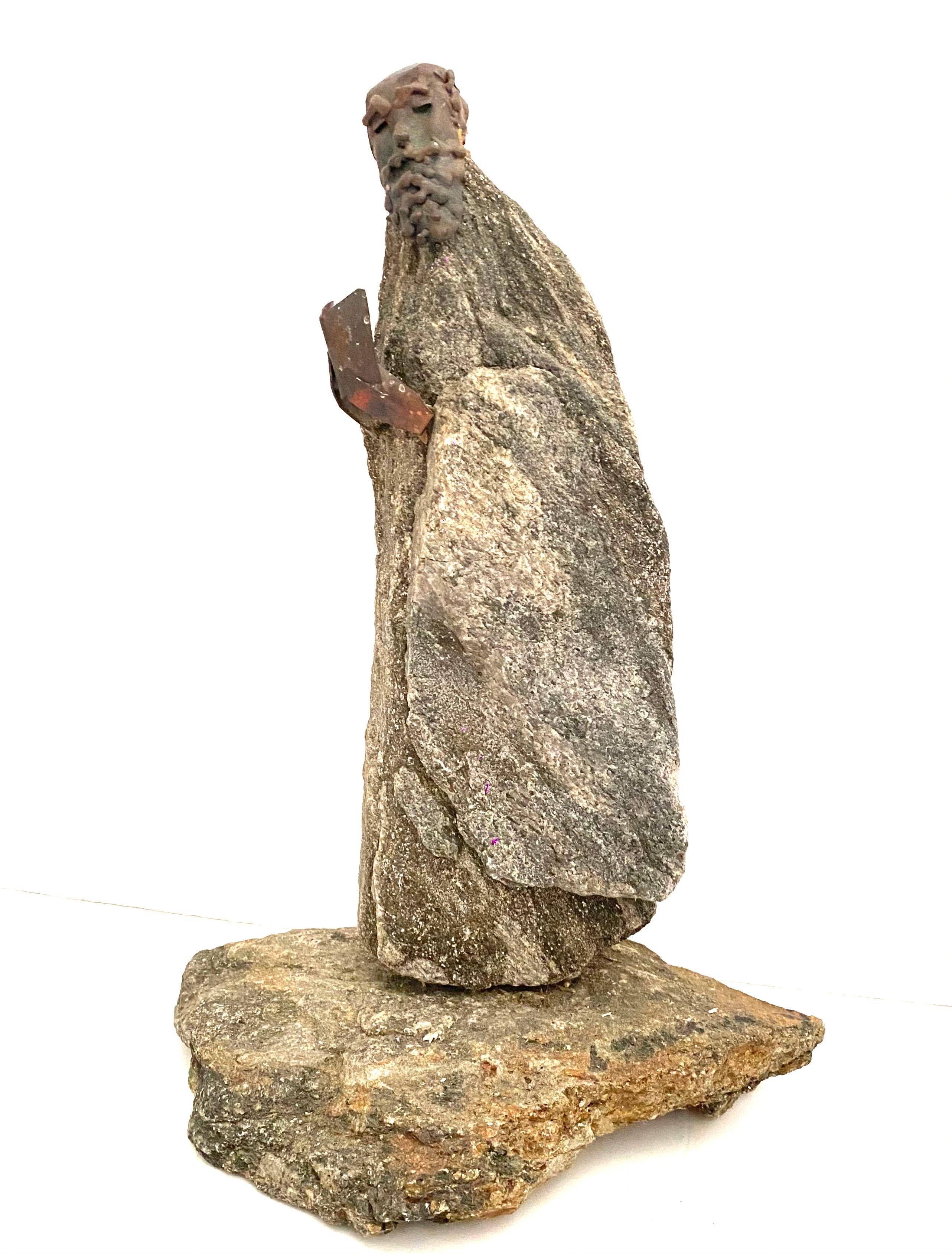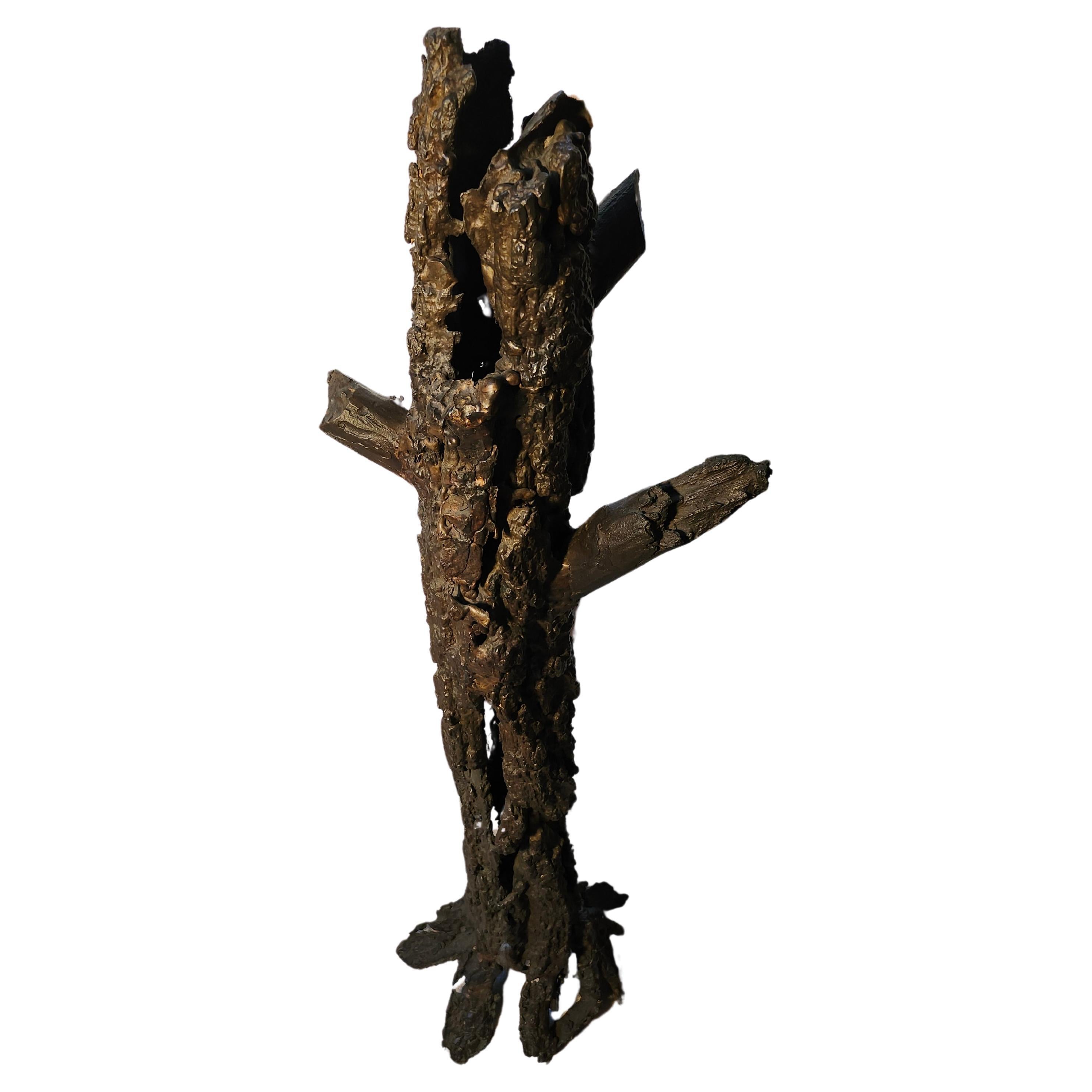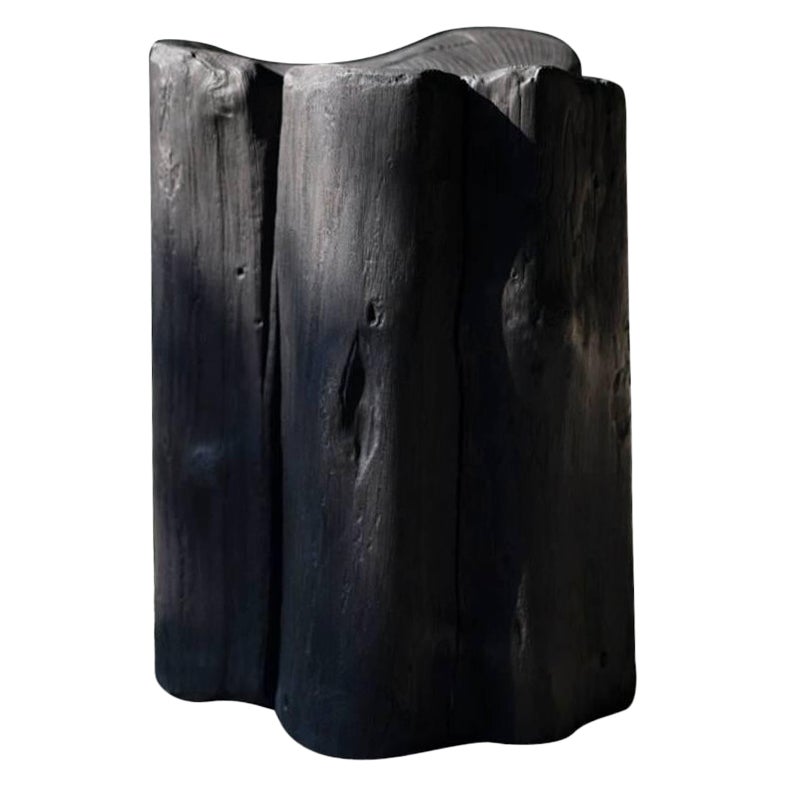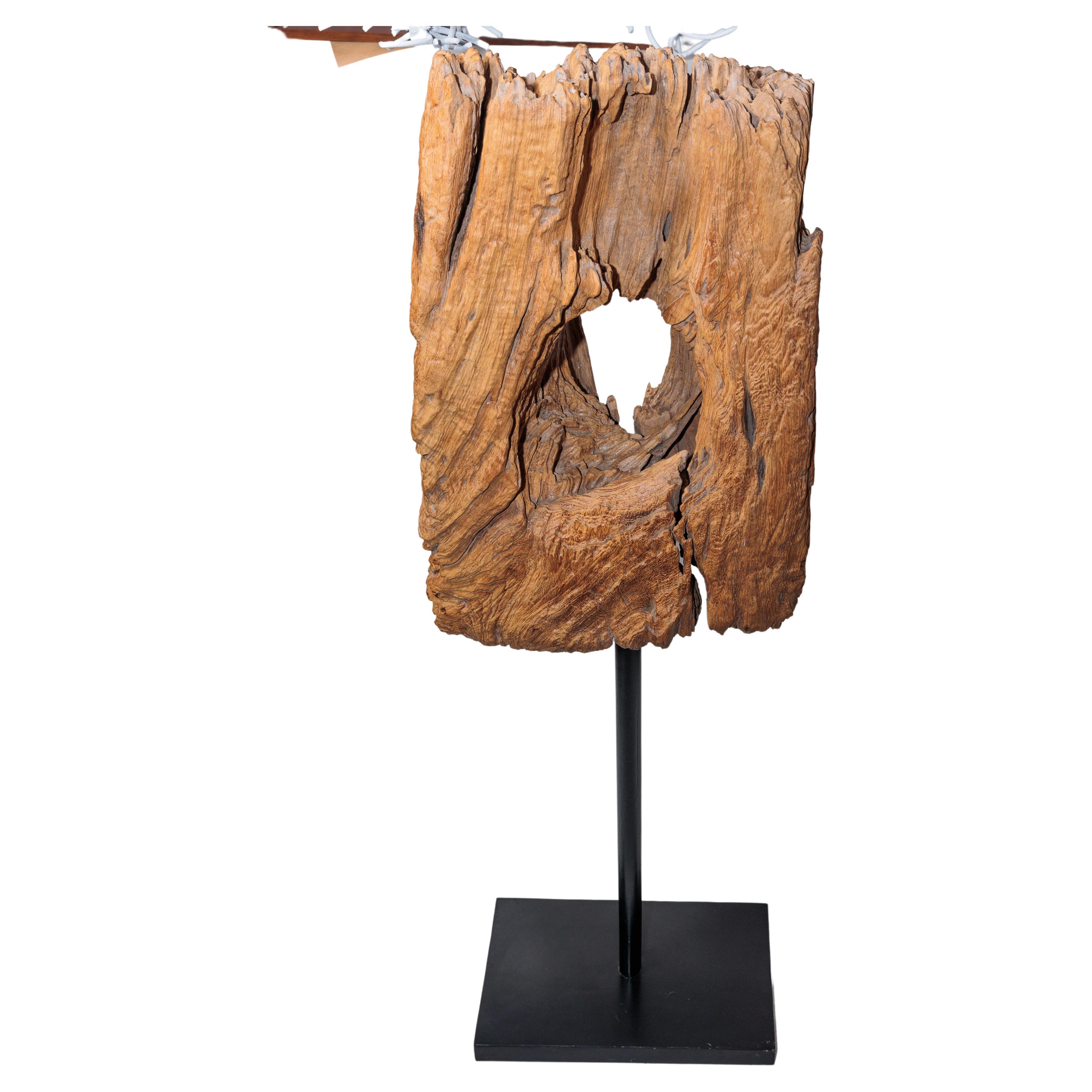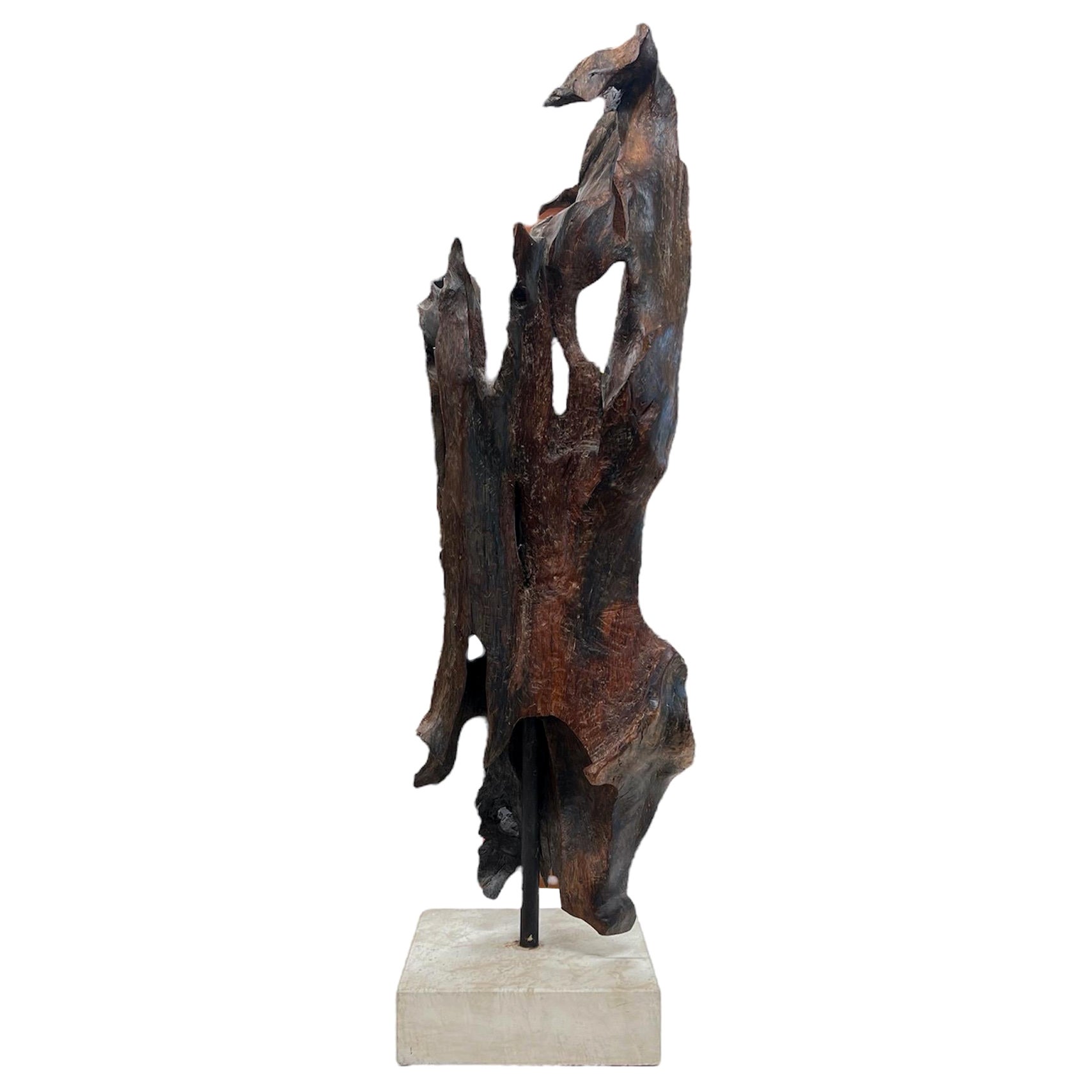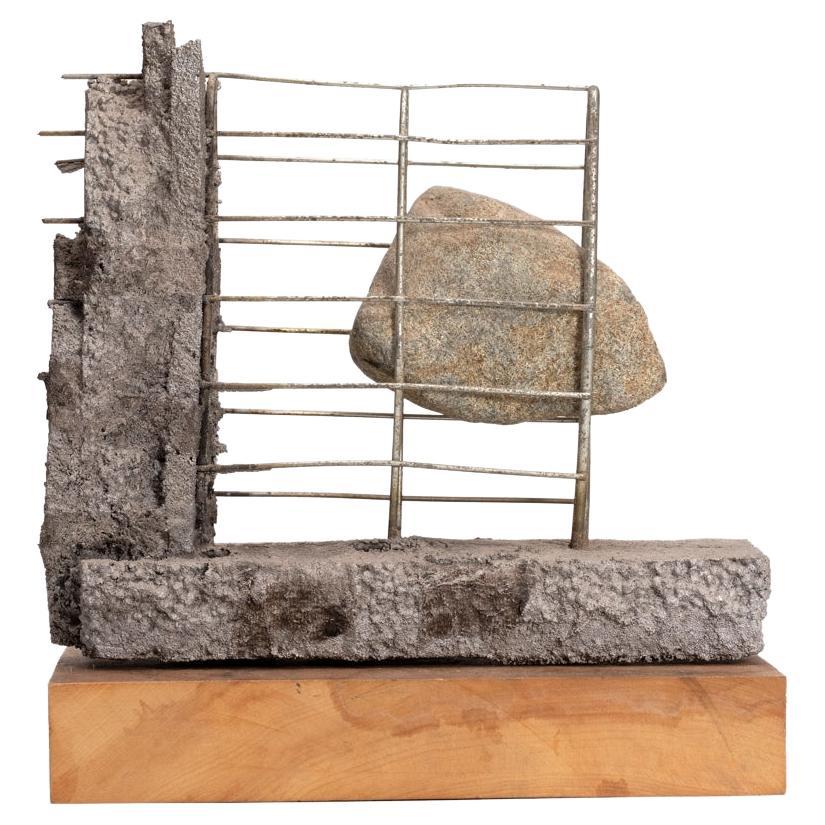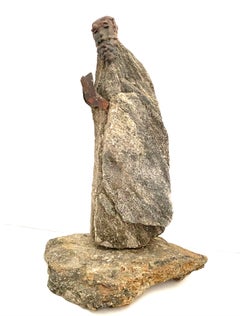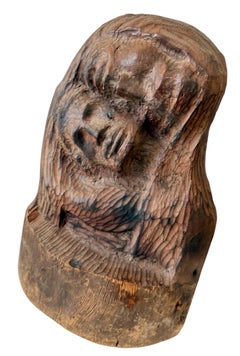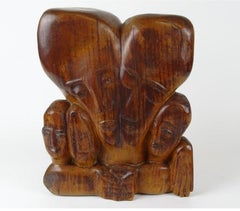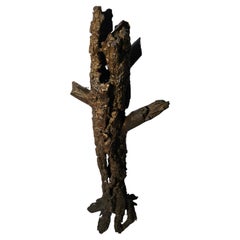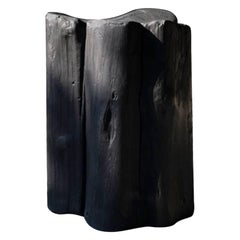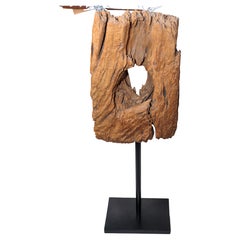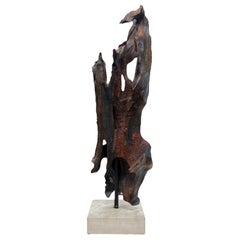Items Similar to Holocaust Memorial Polish Sculpture Burnt Wood Metal Judaica Jewish Memorial Art
Want more images or videos?
Request additional images or videos from the seller
1 of 15
Lubomir TomaszewskiHolocaust Memorial Polish Sculpture Burnt Wood Metal Judaica Jewish Memorial Art
$2,500
£1,898.31
€2,170.86
CA$3,492.86
A$3,884.83
CHF 2,028.54
MX$47,274.20
NOK 25,907.49
SEK 24,296.66
DKK 16,201.95
Shipping
Retrieving quote...The 1stDibs Promise:
Authenticity Guarantee,
Money-Back Guarantee,
24-Hour Cancellation
About the Item
This is a large sculpture in 2 parts it lifts off the base.
Born in 1923, alumnus of the Warsaw Academy of Fine Arts. Student of the Warsaw University of Technology, is an extraordinary artist, searching for his own artistic way. Ambitious, he aims at creating art nobody else has ever created. He is a representative of experimental realism, a versatile sculptor and painter in love with music, nature and women beauty. He inherited his remarkable humanistic and musical talent from his mother, whereas from his father he inherited his technical and engineering talent. Thanks to this exceptional mixture of genes, Tomaszewski combines an engineer’s approach to nature and human beings with the ability to uncover the human soul. He knew he was an artist from the very beginning. He learned to paint before he could even talk: he made his first realistic drawing at the age of two and a half. The complicated course of events led him to settle down in New York region, the city became his new home, where he could find his way to artistic freedom and fame. He has over 150 individual and group exhibitions around the world to his credit. His works decorate the private studies and houses of Lawrence Rockefeller’s family and of the former President of the United States Jimmy Carter.
Lubomir Tomaszewski creates using three different kinds of media: sculpture, paintings “painted with fire” and porcelain. As a sculptor, he uses ready fragments given by nature: stones or rocks, pieces of wood and bark, and combines them with metal or glass to create unique representations of animals, figures or forest spirits. As a painter, instead of a brush, he uses a torch. The technique of painting with fire and smoke offers not only amazing expression possibilities: it makes it possible to achieve the effect of lightness and dynamism, but also an amazing force of expression. No paint can produce such results. What makes the paintings so captivating is their ethereality and power that has a strong impact on the viewers and touches their emotions. Tomaszewski has been mastering this technique for over 20 years.
While creating porcelain figurines, Professor Tomaszewski approaches the subject with great passion, as he treats them as small sculptures. He works on his own unique style and believes that by designing small-scale sculptures he gives people something beautiful, with modern shapes, something that increases the aesthetic level of the society. His adventure with porcelain figures started in the 1950s in the Institute of Industrial Design, where he used to work.
Lubomir Tomaszewski excellent education, his talent and his extraordinary abilities to observe nature and contemporary art led him to found an international artistic movement: he is the spiritual father and the leader of the Emotionalists, a group established in 1994, formed of painters, sculptors, designers, photographers, dancers and musicians.
The New York Times called him “a motion sculptor”. By his works Tomaszewski proves that popular, not necessarily highly abstract, art can bring great joy to many people, but can also evoke other emotions, such as anxiety or fear. Thanks to the fact that he depicts and evokes emotions that are shared by many people, his works are found in private collections, corporations, museums and galleries around the world, and the number of admirers of his sculptures and paintings is constantly growing. LubomirTomaszewski’s works are included in the collections of the National Museum in Warsaw; the National Museum in Kraków; the Warsaw Rising Museum (Warsaw); the National Museum in Wrocław; Halle Museum (Germany); Robert Marston, INC.; Marvin Gliman; Lighting Services INC.; Lawrence Rockefeller and the Rockefeller family; the Ziselman family (Caracas, Venezuela); Jimmy Carter, former President of the United States; T. Komine of Kyowa Bank (Tokyo, Japan), and others.
Awards:
1948 National Award for sculpture ‘Portrait of a Woman’
1955 First Prize, competition for sculptures for the square surrounding
the Palace of Art and Science, Warsaw, Poland.
1956 Third Prize for ‘The Monument of Freedom, Cracow, Poland
1958 Distinction award for sculpture ‘Sport’
1959 Distinction in a two level competition for ‘Monument of Warsaw
Heroes’
1964 Distinction for ‘Nina‘ (coffee set)
1964 Distinction for ‘Dorota‘ (coffee set)
1964 Golden Cross for achievement in industrial design
1983 First Prize in Contemporary Art Exhibit, Slavic Culture Week
1984 Award for Achievement in Sculpture, Perspective Magazine
1988 Third Prize O.A.F., Bruce Museum, Greenwich, CT
1991 Best in Show O.A.F., Bruce Museum, Greenwich, CT
1993 Biennial Award, Museum N.E.C.C.A., CT
1995 First Prize O.A.F., Bruce Museum, Greenwich, CT
1997 Third Prize O.A.F., Bruce Museum, Greenwich, CT
1999 Third Prize O.A.F., Bruce Museum, Greenwich, CT
2000 Second Prize at New Canaan Society for the Arts, CT
2001 Press Award Saumur, France
2002 Touring Exhibition France and Germany
2003 Second Prize “Spectrum” New Canaan Society of Arts CT
2004 Second Prize Polish Art Festival Doylestown PA
2005 First Prize “ Spectrum” New Canaan Society for the Arts
2006 People`s Choice Award National Sculpture Society
2007 Curators Choice Award “Spectrum” New Canaan Society
for the Arts
2007 Second Prize OAF. Bruce Museum, Greenwich, CT2008 – First Prize in “ Spectrum” New Canaan Society for the Arts for
‘Mythical Giant’
2010 American Society of Contemporary Artists, New York, NY, award for “Joy of Dance”
2011 Second Award ‚Illusion’ w New Canaan Society for the
Arts, New Canaan
2012 Honorable Mention New Canaan Society for the Arts for painting
‘It’s Passing’
2013 First prize for ‘Flight over the Stage’ from New Canaan Society
for the Art
2014 First prize for ‘Music of the Forest’ from New Canaan Society
for the Art
2014 Lifetime Achievement Award, Bridgeport University , USA
- Creator:Lubomir Tomaszewski (Polish)
- Dimensions:Height: 24 in (60.96 cm)Width: 40 in (101.6 cm)Depth: 12 in (30.48 cm)
- Medium:
- Movement & Style:
- Period:
- Condition:
- Gallery Location:Surfside, FL
- Reference Number:1stDibs: LU38210806522
About the Seller
4.9
Platinum Seller
Premium sellers with a 4.7+ rating and 24-hour response times
Established in 1995
1stDibs seller since 2014
1,784 sales on 1stDibs
Typical response time: <1 hour
- ShippingRetrieving quote...Shipping from: Surfside, FL
- Return Policy
Authenticity Guarantee
In the unlikely event there’s an issue with an item’s authenticity, contact us within 1 year for a full refund. DetailsMoney-Back Guarantee
If your item is not as described, is damaged in transit, or does not arrive, contact us within 7 days for a full refund. Details24-Hour Cancellation
You have a 24-hour grace period in which to reconsider your purchase, with no questions asked.Vetted Professional Sellers
Our world-class sellers must adhere to strict standards for service and quality, maintaining the integrity of our listings.Price-Match Guarantee
If you find that a seller listed the same item for a lower price elsewhere, we’ll match it.Trusted Global Delivery
Our best-in-class carrier network provides specialized shipping options worldwide, including custom delivery.More From This Seller
View AllPolish Sculpture Granite Stone, Metal Judaica Jewish Holocaust Memorial Art
By Lubomir Tomaszewski
Located in Surfside, FL
Born in 1923, alumnus of the Warsaw Academy of Fine Arts. Student of the Warsaw University of Technology, is an extraordinary artist, searching for his own artistic way. Ambitious,...
Category
20th Century Modern Figurative Sculptures
Materials
Stone, Iron
Rare Chaim Goldberg Kaszmirez Polish Modernist Memorial Sculpture Spertus Museum
By Chaïm Goldberg
Located in Surfside, FL
Deaccessioned from the Spertus Museum in Chicago
Hand signed by artist in wood carving
Chaim Goldberg -- born in the Polish shtetl of Kazimierz Dolny
Chaim Goldberg has worked in ne...
Category
Mid-20th Century Expressionist Figurative Sculptures
Materials
Wood
1965 Canadian Israeli Art Brutalist Abstract Welded Steel Sculpture Eli Ilan
Located in Surfside, FL
Eli Ilan (אלי אילן), 1928-1982 was an Israeli sculptor.
Abstract organic pod shape. in either steel or iron mounted on a wooden plinth.
Ilan was born in Winnipeg, Manitoba. He enrolled in a premedical curriculum at the University of British Columbia in Vancouver and emigrated to Israel in 1948. He then studied prehistoric archaeology and physical anthropology at the Hebrew University of Jerusalem. In 1956, he returned to Canada to study sculpture at the Ontario College of Art & Design. He lived in Kibbutz Sasa from 1959 to 1963. He died in 1982 in Caesarea, Israel.
Education
1955 Hebrew University, Jerusalem, pre-historic archaeology and physical anthropology
1956 Ontario College of Art, Toronto, Canada, sculpture under Thomas Bowie
1959 Training College, Ottawa, criminal identification techniques
1969 Art Festival, Painting & Sculpture in Israel. Ganei Hataarucha, Tel Aviv
Artists: Chana Orloff, Eli Ilan, Zvi Aldouby, Jacob El Hanani, Ludwig Blum, Aharon Bezalel, Koki Doktori, Israel Hadany, Marcel Janco, Dov Feigin, Abel Pann, Esther Peretz Arad, Reuven Rubin, Ivan Schwebel, Jakob Steinhardt, Boris Schatz, Bezalel (Lilik) Schatz, Louise Schatz...
Category
1960s Abstract Abstract Sculptures
Materials
Stainless Steel
Carved Wood German Expressionist Sculpture Jewish Woman Refugee Artist Judaica
By Miriam Sommerburg
Located in Surfside, FL
Miriam Sommerburg (American female artist, born Germany, Hamburg, 1900–1980 New York)
Modernist Wood Carved Sculpture, Carving depictin...
Category
Mid-20th Century Expressionist Figurative Sculptures
Materials
Wood
Mid Century Brutalist Iron, Stone Sculpture, Israeli Master David Palombo
By David Palombo
Located in Surfside, FL
Hand Forged Iron and Drilled Stone Candelabra
Holocaust Memorial Judaic Menorah Sculpture
David Palombo was an Israeli sculptor and painter. He was born in Turkey to a traditional family and immigrated to the Land of Israel with his parents in 1923. They lived in the Nahalat Shiva neighborhood of Jerusalem. In 1940 he began his studies at Bezalel Academy of Arts and Design, and from 1942 was a student of sculptor Ze’ev Ben-Zvi. For a period of time, Palombo was an assistant at Ben-Zvi’s studio and also taught at Bezalel. During this period he was also a member of the “Histadrut HaNoar HaOved VeHaLomed” (The General Federation of Students and Young Workers in Israel). In the 1940s he took art lessons at night. In 1948 he went to Paris, where he visited the studio of the sculptor Constantin Brancusi whose work influenced him. Around 1958 he married the artist Shulamit Sirota. In 1960 he quit his job to devote himself to art. In 1964 he married for the second time to the artist Yona Palombo. The two of them went to live in an abandoned home on Mount Zion in Jerusalem. In 1966 he was killed when the motorcycle on which he was riding ran into a chain stretched across the street to prevent the desecration of Shabbat. His widow opened a museum in their home that was active until the year 2000.
Work by Palombo is included in the Judaic collection of the Jewish Museum (a well known Hanukkah menora). Palombo executed the impressive metal gates of the Tent of Remembrance at the Yad Vashem, the memorial to the martyrs of the holocaust, as well as the gates to the Knesset Building the United Nations Educational Scientific and Cultural Organization (Unesco award) awarded him a scholarship for study in Japan. He worked in marble, granite, bronze, iron and steel. as well as with glass mosaic tiles. Palombo’s early works, in the 1950s, were influenced by modernist sculptors such as Brancusi. These works were composed of abstract images from nature and were carved out of stone or wood. At the end of the 1950s he began making metal sculptors, using the technique of welding. His work took on a more abstract and expressive character.
Education
1940 Painting with Isidor Ascheim, New Bezalel School for Arts and Crafts, Jerusalem
1942 Sculpture with Zeev Ben Zvi, Jerusalem
1956 Mosaic, Ravenna, Italy
1958 Welding Course
Awards And Prizes
1966 UNESCO Award
Exhibitions:
Sculpture in Israel, 1948-1958 Mishkan Museum of Art, Kibbutz Ein Harod
Artists: Zvi Aldouby, Yitzhak Danziger, Arieh Merzer, Dov Feigin, Aaron Priver, David Palumbo, Menashe Kadishman, Kosso Eloul, Yehiel Shemi, Zahara Schatz.
The Spring Exhibition of Jerusalem Artists, Artists' House, Jerusalem
Artists: Palombo, David Bezalel Schatz, Mordechai Levanon, Fima, Ludwig Blum
12 Artists, The Bezalel National Museum, Jerusalem
Avraham Ofek, Aviva Uri, Avigdor Arikha, Yosl Bergner, Lea Nikel, Palombo, Ruth Zarfati,
General Exhibition, Art in Israel 1960 Tel Aviv Museum of Art
Artists: Naftali Bezem, Nachum Gutman, Shraga Weil, Shraga, Marcel Janco, Ruth Schloss
Category
Mid-20th Century Arte Povera Abstract Sculptures
Materials
Stone, Iron
Mid Century Brutalist Iron Sculpture, Israeli Master David Palombo
By David Palombo
Located in Surfside, FL
Hand Forged Iron Candelabra
Holocaust Memorial Judaic Menorah Sculpture
David Palombo was an Israeli sculptor and painter. He was born in Turkey and immigrated to the Land of Isra...
Category
Mid-20th Century Arte Povera Abstract Sculptures
Materials
Iron
You May Also Like
Mid Century Modern Abstract Bronze Sculpture of a Standing Tree Stump Log
Located in Port Jervis, NY
Spectacular Brutalist expression of a standing tree stump log in Bronze. Artist unknown, but definitely from the early 1970s. Amazing artistic craftsmanship. The stump is well balan...
Category
Vintage 1970s American Brutalist Figurative Sculptures
Materials
Bronze
Burned Chunk by Jesse Sanderson
By Jesse Sanderson
Located in Geneve, CH
Burned chunk by Jesse Sanderson, WDSTCK Studio
Artist : Jesse Sanderson
Dimensions: 47 x 30 x 30 cm
Material: Burned wood
Burned chunk_
In search ...
Category
2010s Dutch Organic Modern Natural Specimens
Materials
Wood
$2,288 / item
Unusual Wooden Sculpture with Iron Stand
Located in Bridgehampton, NY
The sculpture is unique in its handmade quality and form.
Category
Mid-20th Century American Mid-Century Modern Natural Specimens
Materials
Iron
Vintage Italian Organic Wood Sculpture 1980s
Located in Los Angeles, CA
The Vintage Italian Organic Wood Sculpture from the 1980s, displayed on a square marble base, is a captivating art piece that harmoniously combines natural wood forms with the elegan...
Category
Vintage 1980s Italian Mid-Century Modern Abstract Sculptures
Materials
Marble
Robert Bielat Sculpture Cast Bi-Metal Stone Wood "TRUE EAST"
Located in Bloomfield Hills, MI
SALE ONE WEEK ONLY
"Robert Bielat was an artist’s artist, a sobriquet applied to those whose work is brilliant but idiosyncratic, deeply compelling in a way that is obvious to those who can see it, but not necessarily so to the market or to the arbiters...
Category
21st Century and Contemporary American Expressionist Abstract Sculptures
Materials
Stone, Cast Stone, Metal, Aluminum
Wood, Metal, Mixed Media Contemporary Sculpture - Explorer 184
Located in New York, NY
Linda Stein, Explorer 184 - Wood, Metal, Mixed Media Contemporary Sculpture
In the 1980s, Linda Stein began a series called Ceremonial Scepters, where she imagined an excavation by...
Category
1980s Contemporary Abstract Sculptures
Materials
Metal
More Ways To Browse
Engineering Art
Small Sculpture Vintage
Small Wood Sculpture
Wood With Glass Sculptures
German Wood Sculpture
German Metal Sculpture
Burnt Wood
Polished Stone Sculpture
Metal Banks
Wood Sculpture Dancers
Burnt Wood Sculpture
Small Metal Figurine
Robert Wood Iron
Women Porcelain Figurines
Kaws Plush
Ken Potter Artist
Kennedy Musekiwa
Richard Macdonald Golf
